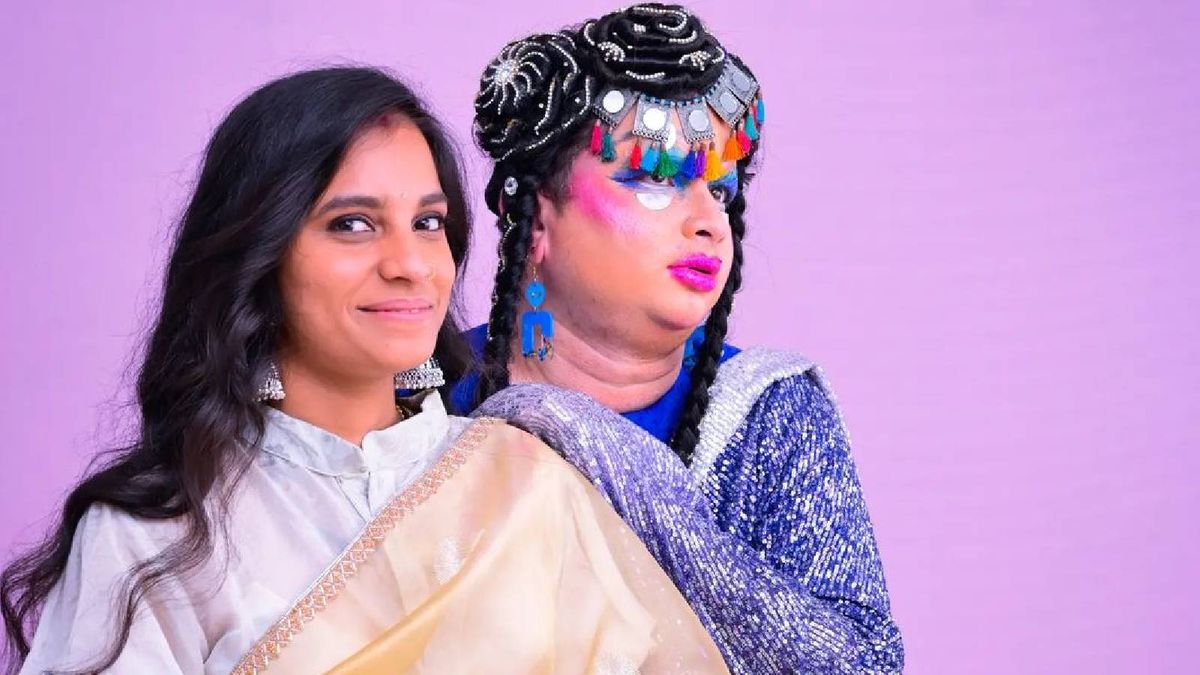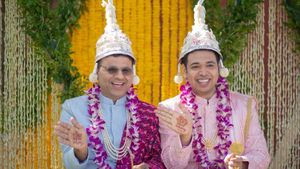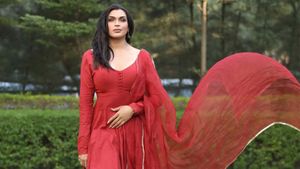Drag has been a life-changing experience for Patruni Chidananda Sastry who identifies as pansexual and is India’s first-ever drag queen married to a heterosexual woman. From his marriage to cis gender woman Raja Rajeshwari Devi being misconstrued as a lavender marriage to being bullied while growing up, Sastry’s journey is all about courage and acceptance. In a recent conversation with Zee Zest, the Hyderabad-based artist gets real about his extraordinary love story with Rajeshwari and how she’s his biggest support system.
Excerpts from the interview:
1. Tell us about your marriage with Rajeshwari. What made you both fall for each other?
During lockdown, I hosted live shows online during Pride month and noticed an unfamiliar account following my every move and showing up at every live show I put on. Months later, at a family function where a relative put a little too much kumkum on my forehead, which then went into my eyes, I met Raji. I felt a warmth I’d never experienced and then realised she was offering me a towel to clear my eyes. A few minutes into the conversation, she asked me an amusing question, “What is drag?” I thought it came out of nowhere. I didn’t realise at the time that my “adoring social media fan” was none other than Raji.
Our little conversations led to an exchange of numbers and then finally, a romantic relationship. After a few months of dating, I was still sceptical about revealing my sexuality. I dropped her a text one day: I am pansexual. The next day, I got back two weblinks about pansexuality and a question: “Is this what you meant?” I needed to know whether she understood me, so I called her. “It doesn’t matter what your sexuality or gender is. I may not fully understand these words and feelings, but it only matters whether you love me and wish to be with me,” she said.
As time passed, we decided to make this bond stronger by marrying each other. I had realised that I felt no pressure to be with her; I just felt happy and the most seen with her. When I opened about my relationship, people questioned my queerness. They put me in a box of their assumptions, a place I didn’t want to be. I made it through all the judgement because of Raji, holding my hand firmly throughout. That support made it clear that I was marrying her for myself, and she would help me live my most authentic self.
2. How does it feel to be the first drag queen married to a heterosexual?
I'm married to a cis-gender woman and I came out to her during our initial conversations. I remember one of the things she told me, “I understand where you are coming from, I might not understand your complete journey of sexuality and gender, but I could see the love you are resonating and I want to be in for it.” People think a pansexual person married to a heterosexual person makes both heterosexual but that's not how it works. Being married to a cis women didn’t change me as an individual. The feelings are the same, the heart is the same, the brain is the same, it's just now I have someone to rely on, and that is something really beautiful.
3. As a couple what were the challenges you faced?
When I opened up about my marriage to the people via Instagram, I received mixed reactions. I got hate from both the queer community as well as the straight community. My queer friends thought that I was hiding my sexuality from her, or thought I was giving her false assumption. Some even thought that our marriage was a lavender marriage. There was immense trolling of people calling this relation as disgusting and unworkable. There was also a huge resistance from queer friends to support me. I was called off from many events and my presence at those events as a bi/pan person was attacked. I had to wake up every morning to hundreds of hate messages from some unknown drag queens across the globe asking me to restrain from doing drag and that was a huge problem. However, it was only when my wife stood behind me supporting me and openly acknowledging me as a pan/bi person was when people understood. Post that I got a lot of support and positive comments. Many closeted bi/pan people reached out to me to tell how they wish to be like us and young bi/pan people said that they got hope to see the world been better place for bi/pan sexual people.
4. How did people in your family and hers react to your relationship?
When I came out to my family, they didn’t know anything about it but took time to understand it themselves. For Raji’s family I didn’t make an effort, I left it to her, as I wanted her to understand and take the call if there is a need to come out.
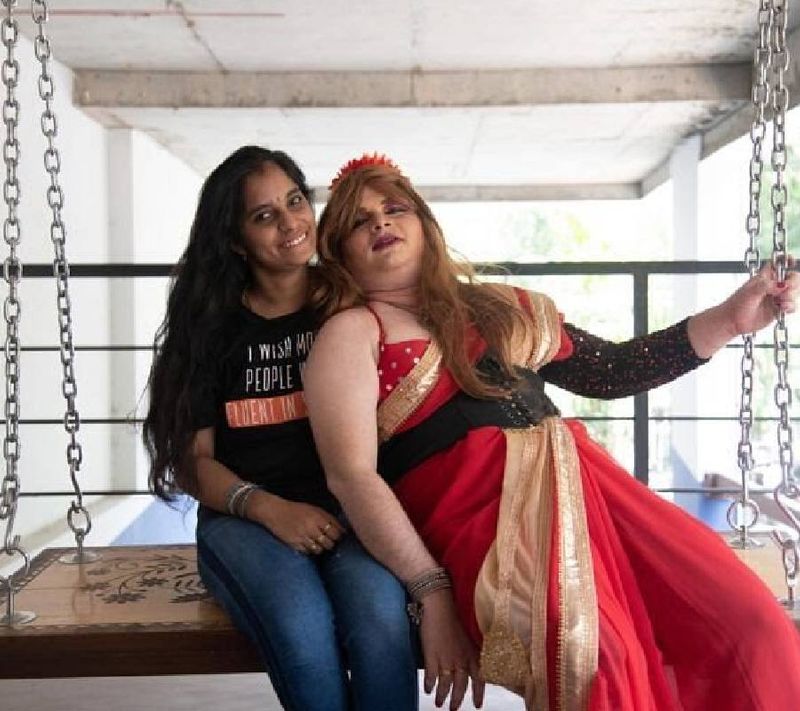
5. Define your relationship with Rajeswari. How can your marriage be an inspiration to others?
Before marriage there was a lot of self-doubt and uncertainty which I don’t have now. My partner has been a huge support system for me to make me be myself and ensure to stay with me in highs and lows. My artistic vision also shifted from being more diverse than ever, creating works which are more in-depth experiences. I believe marriage helped me rely emotionally on my partner and her support added a little more glam to my creative process. She is a huge supporter of my drag, initially she started as an admirer and soon she started becoming a part of it. She paints my face and creates a visionary look. She also helps me in getting ready. Though we often fight about choosing a saree, she ensures to make me beautiful. When it comes to ideas and styling, she always helps me find the colour palette and right accessories to get on board.
6. What was it like to come out as a drag queen?
When I moved to Hyderabad in 2018. I was invited to perform at Lamakaan for a queer film festival. I got involved with people from the LGBTQIA spectrum, I realised that I was also not heteronormative. I did a dance on coming out and that became a milestone performance. However, once section 377 was struck out, I came out to the world as gender fluid at the age of 21.
7. Why did you decide to do drag in Hyderabad?
I wanted to bring the drag scene to Hyderabad but never wanted to be the skin in the game, however when I asked a couple of friends to try drag, they refused and said, “If you can't do it yourself how would someone else do it?” and that made a huge change. When I decided to do drag in Hyderabad, I wasn’t getting any performance spaces as people thought it to be a vulgar art form. After getting shut out by multiple spaces, I reached out to Bhagi Sravani, who owned Nirvana café then, I spoke to her and curated an event for the first time. I expected to have 21 people but we got an outpouring of more than 500 people. That was when I realised how people saw drag as empowering. I never wanted to be beautiful and wanted to try out something different, something weirder. I started learning about Tranimal drag, an alternative art form in which drag is shown as anti-beauty or as disgust. Trash is used as a statement for fashion, and it always has an element of superficial. I adapted to this and started performing.
8. Take us through a typical day as a drag artist?
On a regular day I wake up, do my day job for nine hours and then pack my belongings to go to an event in the evening. Sometimes when there is no event, I dress up in the comfort of my home and create content for my social media. Every day is different, I meet people from all walks of life. Sometimes I perform at posh pubs and hotels and the very next moment I perform at a bus stop or a metro station. This is how it shifts. By the time I come home my face is full of glitter, the house is completely littered, so I take a hot bath and go to bed. This is how my day looks like.
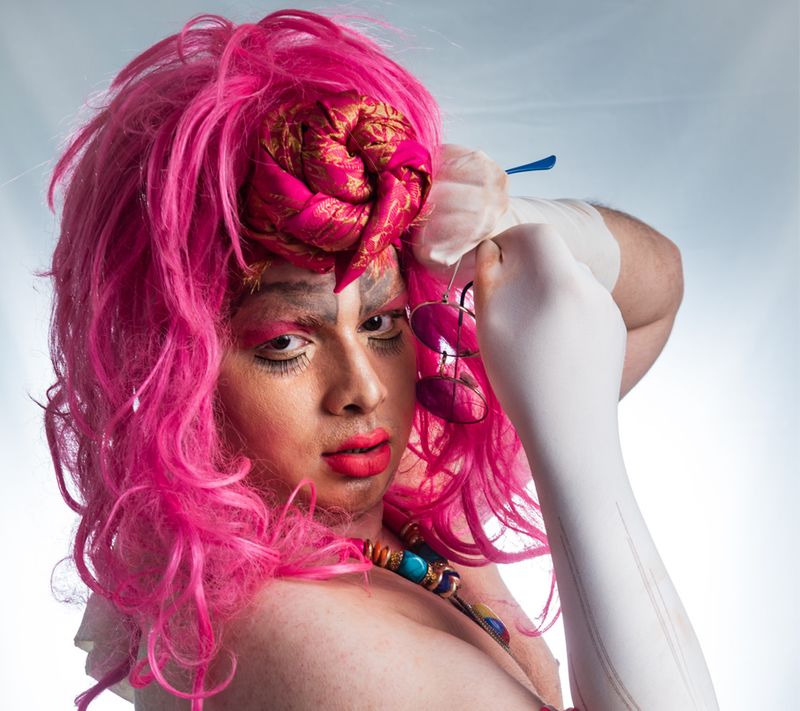
9. How would you describe your drag style?
While learning performance art and talking about drag, I understood that drag is itself a performance art. But, unlike traditional drag, in which performers are praised for their elegance and beauty, I was attracted to tranimal style–also called “drag terrorism”. Tranimal drag is the drag of poor, available drag queens. It does not throw money on clothes and cosmetics and works on only one belief: “this will do”. Tranimal drag performers make outfits themselves with available trash. They look vigorous, and they momentarily erase beauty and gender norms. When I perform tranimal, I am liberated, I become the drag queen who doesn’t wear heels, but performs bare footed for the less privileged community that I try to remind myself of. My art is easy, accessible, and available for the people, which has made a connection with the audience. People weep through the performances time and again. Sometimes they share their personal stories. Because of art, even activism becomes reachable and simple.
10. How do you express yourself through drag?
Drag is political art in itself. Here we question the politics of the body. Society tells us to wear a certain type of clothing and questions the politics of gender. It's important to understand that drag is one of the most interdisciplinary art of all time and can be done in many ways. I use drag as a medium to talk about queer subjects like homosexuality and political situations such as the transgender bill. I work in live performance art and events where I talk about crucial situations and reflect my ideologies. The best part about art is that it can portray anything and everything. Art can be used as a tool of activism. I do not believe that activism has to be rigid or cutthroat. Sometimes my visible existence becomes activism. Sometimes when I walk into drag it becomes a part of me or kind of creates an activist movement, through myself, to normalise things that people would be seeing.
11. Growing up, did you face bullying in school, neighbourhood or family?
I was always bullied in school and college life, being someone who was gender variant, people always used to call me names and other things time and again, it was really painful to grow in such an environment, but my dance helped me navigate through the bullying time and again.
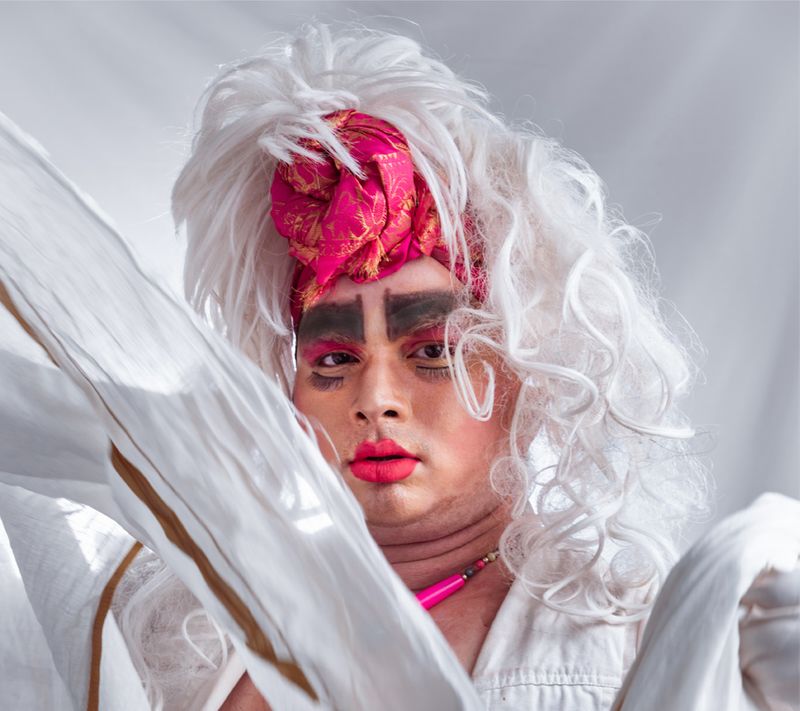
12. What does Pride mean to you?
Pride for me is to celebrate the queer existence in every speck of live. I believe people from the LGBTQIA++ community are kept in veil for too long and it's high time to get complete acceptance of both queer people and their intersections to make this society more inclusive.
13. Your advice to the young generation still trying to discover their real identity?
I would say it's ok to take time, it's ok to not come out as well. It's what we see being comfortable. Sometimes people don't want to take the extra pressure to come out and that's fine too and coming out is not a onetime thing, it happens always. We need to be doing it again and again and that's how we are who we are. So no pressure, let's put ourselves first.


